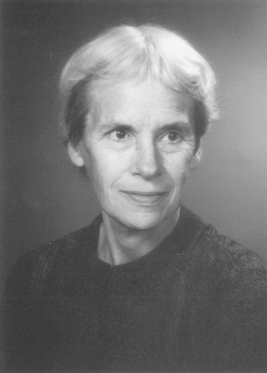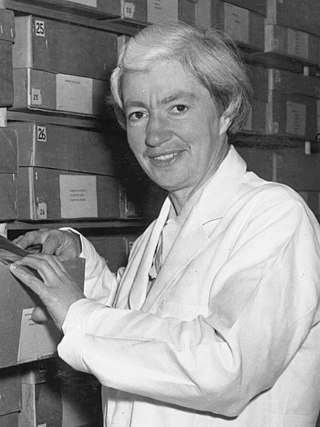
Radio astronomy is a subfield of astronomy that studies celestial objects at radio frequencies. The first detection of radio waves from an astronomical object was in 1933, when Karl Jansky at Bell Telephone Laboratories reported radiation coming from the Milky Way. Subsequent observations have identified a number of different sources of radio emission. These include stars and galaxies, as well as entirely new classes of objects, such as radio galaxies, quasars, pulsars, and masers. The discovery of the cosmic microwave background radiation, regarded as evidence for the Big Bang theory, was made through radio astronomy.

Colleen Margaretta McCullough was an Australian author known for her novels, her most well-known being The Thorn Birds and The Ladies of Missalonghi.

Ellen Dorrit Hoffleit was an American senior research astronomer at Yale University. She is best known for her work in variable stars, astrometry, spectroscopy, meteors, and the Bright Star Catalog. She is also known for her mentorship of many young women and generations of astronomers.

Ruby Violet Payne-Scott was an Australian pioneer in radiophysics and radio astronomy, and was one of two Antipodean women pioneers in radio astronomy and radio physics at the end of the second world war, Ruby Payne-Scott the Australian and Elizabeth Alexander the New Zealander.

Dorothy Hill, was an Australian geologist and palaeontologist, the first female professor at an Australian university, and the first female president of the Australian Academy of Science.

Nancy Grace Roman was an American astronomer who made important contributions to stellar classification and motions. The first female executive at NASA, Roman served as NASA's first Chief of Astronomy throughout the 1960s and 1970s, establishing her as one of the "visionary founders of the US civilian space program".
Sir Alexander Oppenheim, OBE FRSE KT PMN was a British mathematician and university administrator. In Diophantine approximation and the theory of quadratic forms, he proposed the Oppenheim conjecture.
Carl Alexander Gibson-Hill was an English medical doctor, naturalist, ornithologist and curator of Singapore’s Raffles Museum.
The Royal Astronomical Society of New Zealand (RASNZ) is the New Zealand national astronomical society. It is an association of professional and amateur astronomers with the prime objective to the promotion and extension of knowledge of astronomy and related branches of science.

Janet Vida Watson FRS FGS (1923–1985) was a British geologist. She was a professor of Geology at Imperial College, a rapporteur for the International Geological Correlation Program (IGCP) (1977–1982) and a vice president of the Royal Society (1983–1984). In 1982 she was elected president of the Geological Society of London, the first woman to occupy that position. She is well known for her contribution to the understanding of the Lewisian complex and as an author and co-author of several books including Beginning Geology and Introduction to Geology.
Sir Norman Stanley Alexander was a New Zealand physicist instrumental in the establishment of many Commonwealth universities, including Ahmadu Bello University in Nigeria, and the Universities of the West Indies, the South Pacific and Botswana, Lesotho and Swaziland. He was knighted in 1966.
Sarah Salmond was a notable New Zealand governess and astronomer.

Lucy Beatrice Moore was a New Zealand botanist and ecologist.
Elsa Beatrice Kidson was a New Zealand soil scientist and sculptor.
Muriel Emma Bell was a New Zealand nutritionist and medical researcher.

Emily Stewart Lakdawalla is an American planetary geologist and former Senior Editor of The Planetary Society, contributing as both a science writer and a blogger. She has also worked as a teacher and as an environmental consultant. She has performed research work in geology, Mars topography, and science communication and education. Lakdawalla is a science advocate on various social media platforms, interacting with space professionals and enthusiasts on Facebook, Google+ and Twitter. She has appeared on such media outlets as NPR, BBC and BBC America.
Gloria Lim BBM was a Singaporean mycologist whose research focused on tropical fungi and who built up a fungal repository of regional samples. Lim was twice appointed as Dean of the Faculty of Science at the University of Singapore, the first woman to hold that position. After her retirement, she became the first Director of Singapore's National Institute of Education and helped it launch a university degree program. She served on the Public Service Commission as its first woman commissioner for 14 years, and then served as general manager of the Community Mediation Unit for 8 years.

This is a timeline of women in science, spanning from ancient history up to the 21st century. While the timeline primarily focuses on women involved with natural sciences such as astronomy, biology, chemistry and physics, it also includes women from the social sciences and the formal sciences, as well as notable science educators and medical scientists. The chronological events listed in the timeline relate to both scientific achievements and gender equality within the sciences.
Elizabeth Alice Flint was a New Zealand botanist who specialised in freshwater algae. She co-authored the three-volume series Flora of New Zealand Desmids in the 1980s and 1990s.

Sir George Vance Allen was an Anglo-Irish British medical doctor, bacteriologist and academic administrator who served as the first Vice-Chancellor of the University of Malaya.










